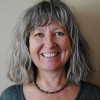Many of my clients are concerned with limitations caused by arm and shoulder pain. Although each client has a unique situation, I have chosen this case as an example of the way in which Bowenwork™ can affect limited movement and pain that has developed slowly out of a chronic pattern of use.
As human beings, we carry a lot on our shoulders and hold a lot in our arms. Anything from injuries to worries to relationship demands to habitually sitting at a computer can affect the mobility of the ribs and shoulder girdle.
Typically by the time we are adults, the upper torso is held still in an immovable block, which constrains the breathing and even hampers the flow of our emotions. This holding pattern also limits fluidity when twisting, reaching, turning, and bending—practically anything we engage in a normal day that involves moving, feeling, and breathing.
This holding pattern becomes a deeply ingrained habit in the unconscious brain, because by now the nervous system has forgotten the lightness and changeability that was once taken for granted. Needless to say, with all these factors in place, it takes a little prompting to reintroduce comfortable movement.
Peter, a retired automotive engineer, came to me with chronic pain in his left arm. Driving for more than ten minutes raised his pain level, bike riding was no longer possible, and he had to sleep in careful positions using pillows to prop up his head and neck. He could still hike without aggravating his arm, but was concerned that this too may become impossible.
His doctor had diagnosed a herniation at C7, which is located at the base of the neck. Peter had already tried epidurals (anesthetics), the first of which eliminated 95% of his pain for six months. The second, however, was less effective and lasted a shorter period of time. He had also tried traction and acupuncture, with little benefit. Peter wanted another approach, so he called me for an appointment.
On examination, I found that in raising his left arm out to the side (he is left handed), pain began at the top of his shoulder and radiated into his fingers. More importantly though, over the years gravity had curved his spine into the shape of a C. This puts a tremendous amount of stress on the neck and disempowers the pelvis from acting as a base of support in virtually all movement. In other words, he had overworked the base of his neck because he had been under-using the rest of his spine. Eventually, it showed up as arm and shoulder pain.
We began the first of several Bowen treatments. Using pillows to support his head and neck, I did foundational Bowen moves on his spine to reset over-all balance and to introduce our approach to the nervous system. Change is inevitable when the nervous system is engaged in our process!
As the treatment progressed, he experienced prickling sensations that lasted about five minutes under both shoulder blades and up into his neck and left arm. This Bowen “unwinding” can take many forms and is a sure sign that the nervous system is making good use of the treatment.
During his second appointment, Peter reported having felt relief over the past week. He could drive somewhat longer in comfort, and in general his pain was less extreme. For the second treatment, I repeated what I had done the first time and added several more moves focused specifically on the shoulders and arms.
This time, his upper back and neck tingled, confirming once again that his body was fully engaged in the process. Afterward, I assigned two exercises designed to open movement in the shoulder blades and ribs.
Two months later, I saw Peter twice again. He had continued with an expanded exercise program until experiencing a setback from two days of bike riding. I treated him twice in two weeks, continuing the theme of affecting the underlying pattern that was causing the pain.
One month later I focused my treatment on his head, neck and pelvis. He reported that by this point his shoulder and arm pain were only an annoyance.
I was pleased to hear of his growing awareness of the relationship between left and right shoulders. He’d also discovered that lengthening his spine immediately affected his pain level. He was clearly developing a degree of self-awareness that could only increase his pleasure in his favorite activities.
Five weeks after his last appointment, Peter left a message on my answering machine: “Everything so far is good news. Practically all of my shoulder pain is gone. I’m continuing to do the exercises. As a matter of fact, this week I even stopped using the pillow under my neck to stay out of pain.
“I’m getting just a little feedback in my shoulder, but it’s less than when I started. I’m going to continue with the exercise program, and hopefully within another month or so the pain will disappear altogether. For the time being, things are going very well.”
Bowenwork™, with its minimal intervention, can trigger a healing process that affects every area of life. Add to that a client who is dedicated to a regular exercise program, as well as to setting limits so that he or she can heal, and the results will be evident.


